
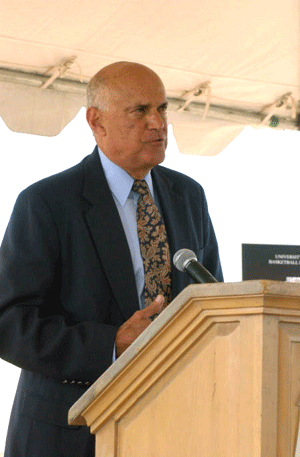 While
it certainly appeared that the Lobos had found their leader, most people
in Albuquerque still weren't convinced. To them, the only real
power guiding sports at the University of New Mexico could be summed-up
in two simple words: Lobo Basketball. For it's new athletic director,
this was both a blessing and a curse, so he immediately set out to fatten-up
the other sports without killing the sacred cash cow. While
it certainly appeared that the Lobos had found their leader, most people
in Albuquerque still weren't convinced. To them, the only real
power guiding sports at the University of New Mexico could be summed-up
in two simple words: Lobo Basketball. For it's new athletic director,
this was both a blessing and a curse, so he immediately set out to fatten-up
the other sports without killing the sacred cash cow.
In
Dave Bliss, he had inherited a basketball coach who would go on to win
more games than any coach in New Mexico history. He also inherited an
arena considered by many at the time to be one of the toughest anywhere
in the country for an opponent to play. To go along with that, he acquired
a rabid group of fans to go inside of that arena, many longtime season
ticket holders (10,000 in 1992 - 14,000 by 1999) who had kept the Pit
top ten in national attendance since 1966.
The
flip side to all of this was that for New Mexico, Lobo basketball really
was the sacred "cash cow." Unfortunately, it was also a cow that
existed on a very poor farm. That farm also tended to be populated by
farmers with unrealistic expectations, selective tastes, and very short
memories.
Only
twelve years earlier, the program had almost disappeared completely
in the infamous scandal known as Lobogate. That it survived at all is
as much a tribute to those fans as it is to any other thing. Even after
sanctions and defections decimated their team, those fans continued
to fill the arena and cheer for a team comprised mostly of walk-ons
and football players - with a few good players sprinkled in. It was
then - as it still is today, their finest hour.
But
that was then and this was now.
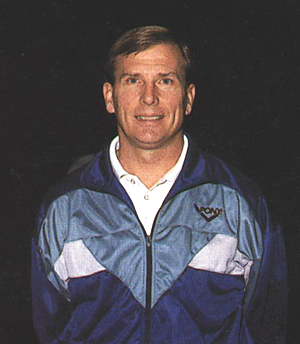 By
1992 those fans had become less patient and far more demanding. Fortunately,
Bliss had taken the team to the NCAA tournament the year before for
just the fourth time in school history and for the first time since
the scandal-ridden year of 1978. This was to be a rebuilding year for
Bliss however, and he would not return his team to the tournament this
season. He would return it to the big dance in 1993 however,
starting a string of six straight tourney appearances. By
1992 those fans had become less patient and far more demanding. Fortunately,
Bliss had taken the team to the NCAA tournament the year before for
just the fourth time in school history and for the first time since
the scandal-ridden year of 1978. This was to be a rebuilding year for
Bliss however, and he would not return his team to the tournament this
season. He would return it to the big dance in 1993 however,
starting a string of six straight tourney appearances.
It
is important to note that this six-year run was exactly two more tournament
appearances than the university had received in its previous 100-year
history, and all six of them under the careful watch of Rudy Davalos.
This
was not the miracle cure that would solve all of his problems though,
as Rudy Davalos understood all too well. Struggling to fund the rest
of his athletic departments with only one real moneymaker, the obvious
(though only partial) solution was to increase the gate at the other
sporting events - especially football.
Unfortunately,
the fans and the administration's apathy towards anything non-basketball
related was legendary, and was the single biggest reason for the failure
of other sports at UNM. Little did most fans know at the time, but it
also adversely affected recruiting for the basketball team, and contributed
to the general lack of respect that they received from national sportswriters
during the basketball season.
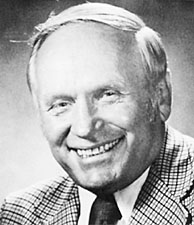 Consider
the story of former athletic director John Bridgers. Beginning in 1979
and finishing in 1987, Bridgers saw both the best and the worst of Lobo
athletics during his career. Arriving here from Florida State, he was
handpicked to bring the basketball program back from the smoldering
ashes of Lobogate. Working in tandem with the under-appreciated efforts
of Coach Gary Colson, they were able to regain much of the respect the
program had lost, while putting the "tainted goods" of the past far
behind them. Consider
the story of former athletic director John Bridgers. Beginning in 1979
and finishing in 1987, Bridgers saw both the best and the worst of Lobo
athletics during his career. Arriving here from Florida State, he was
handpicked to bring the basketball program back from the smoldering
ashes of Lobogate. Working in tandem with the under-appreciated efforts
of Coach Gary Colson, they were able to regain much of the respect the
program had lost, while putting the "tainted goods" of the past far
behind them.
It
was to be the magical season of the football team in 1982 however, that
became his legacy. Finishing 10-1 that season, the Lobos still somehow
failed to get a bowl bid in what ranks as one of the most grotesque
oversights in school history.
Reportedly,
the empty seats at University Stadium had turned off bowl officials,
even though the miniscule average of 23,236 per game was by then, the
second best attendance figure in school history.
Although
disappointed about the snub, Bridger's main concern at the time was
in retaining his suddenly popular head coach, Joe Morrison. Unfortunately,
the school administration did not share his concern, and Morrison bolted
for South Carolina and three times the salary, where he would coach
the Gamecocks to three bowl games before prematurely dying of a heart
attack in 1989.
 That
particular story - of Joe Morrison leaving New Mexico for South Carolina,
is a story in and of itself. That
particular story - of Joe Morrison leaving New Mexico for South Carolina,
is a story in and of itself.
In
December 1982, USC athletics director Bob Marcum was looking for a head
football coach after the then current head coach, Richard Bell, had
thudded to a 4-7 mark for the Gamecocks. Originally, Marcum knew Joe
Morrison only by reputation, as the New York Giants' all-pro back turned
college coach. But the two men had become friendly three years earlier,
when they met at the Walter Camp All-American banquet in New Haven,
Conneticut.
When
Bell was relieved of his duties, another NFL legend, Sam Huff, suggested
that Marcum contact Morrison, who had just finished a 10-1 season at
New Mexico. and as it turned out, was ready to jump ship
"We
played Hawaii the last game of the season, a chance to win the WAC (Western
Athletic Conference), and there's 19,000 in the stands," Morrison
assistant Jim Washburn says. "The Lobos won, but no bowl bid would
be forthcoming." Afterward, Joe Morrison said, 'That's it' and
we were gone."
For
Morrison, who had coached 10 years at Chattanooga and New Mexico, South
Carolina represented the big time. A visit to Columbia and 72,400-seat
Williams-Brice Stadium sold Morrison on the spot. That night, in the
bar of the Carolina Inn, he and Marcum wrote out a rough contract on
a cocktail napkin, as reported by the Gamecocks Sportscenter.
Joe
and his staff arrived in Chattanooga wearing jeans and cowboy boots,
completely unaware of the stir they would soon cause.
"We'd
been coaching out where no one cared who we were (New Mexico),"
Washburn says. "Joe liked to go out and drink beer together the
night before a game, so he asked someone where a good place was."
That
night, the staff wound up at a club in northeast Columbia. When a local
asked Washburn, "Isn't that Joe Morrison?" the assistant said,
"Yeah, but keep it quiet, he just wants to hang out and listen
to music."
Instead,
the man grabbed a microphone and announced their presence to patrons.
"Then they played the fight song, and next thing you know, the
place fills up," Washburn says. "That's when we realized we
weren't in Albuquerque any more."
No
they weren't. While Joe and his staff would enjoy some initial huge
successes in South Carolina, the future would be a dark one filled with
death and NCAA violations.
Two
decades have passed since Joe Morrison and his coaching staff rode out
of New Mexico and hit South Carolina with the force of a tornado. Their
arrival inspired the Gamecock nicknames of "Fire Ants" and
"Black Magic," and they won a school-record 10 games
in 1984, along with eight each in 1987 and 1988.
Unfortunately,
they also left South Carolina saddled with an ugly legacy as the school
where the term "steroids abuse" first came to national light.
Less than a year later, Morrison was dead, nearly half his staff was
under criminal indictment, and the others were long gone.
Defensive
coordinator Tom Gadd and secondary coach Tom McMahon would both be dead
of cancer before age 56, joining Morrison, who had suffered a fatal
heart attack at the much too-young age of 51.
The
three coaches who pleaded guilty in 1989 to involvement in the steroids
scandal, triggered by an October 1988 Sports Illustrated article were
all spent as well. Strength coach Keith Kephart and tight ends coach
Tom Kurucz saw their coaching careers all but ended, while Washburn,
the defensive line coach, spent years in coaching and financial purgatory
before reaching the NFL.
Running
backs coach Ricky Diggs? A painful divorce, health problems and a turbulent
professional life. Linebackers coach Bill Michael and offensive line
coach Mike Bender? Each nearly lost his wife, one to cancer, the other
to an impatient motorist.
And
most infamous of all, receivers coach Tank Black, became the national
poster child for unscrupulous player agents, and is now prison for crimes
ranging from fraud to money laundering.
Others
associated with the program also had misfortune. Bob Marcum, the athletics
director who hired the staff, lost his wife, Cecile, to cancer. Terry
Lewis, the team trainer, died last fall at 58 of a heart attack. Morrison's
widow, JeVena, died in 1995.
Nothing
but tragedy.
Few
of the assistants Joe Morrison retained in Carolina came with him from
New Mexico, but the point still needs to be made of how often this is
a life and death business, and it takes an extraordinary leader to take
a middle-of-the-road school like New Mexico and make it successful without
taking any similar shortcuts or leaving the school for the first greener
pasture.
This
is a tough business.
Former
UNM athletic director Bridgers,
now retired and living in Florida, still bristles with bitterness when
recalling his days with the Lobos.
"I
know (Morrison) never felt the administration was giving him the support
it should - he was right," said Bridgers. "A coach can't do it by himself,
I don't care how good he is. A lot of people felt football was worthless
and did not want to give it any support at all."
Bridgers
knew what he was talking about. Prior to coming to UNM he had been the
AD responsible for turning Florida State into a national power - and
for hiring legendary coach Bobby Bowden. The gross indifference that
the UNM administration had displayed would cost the school for many
years to come, as the Lobo football team would go eleven straight
years without another winning season.
"Among
the people who had the leadership", he said, "there weren't enough of
them who saw the need for a good football program. As a result, it struggled
and did not achieve the level of success I always felt it could."
John
Bridgers never gave up, and in fact, he had plans to add 4,000 seats
to university stadium, which at the time had a capacity of 30,646.
Without
any support from the administration or regents, he was able to raise
$1.2 million in cash and pledges towards the $2 Million project. But
once again, Bridges good intentions fell upon deaf ears. University
president Gerald May informed the athletic director to return all of
the money and donations.
"I
never understood that," Bridgers said. "A good program is not going
to just come by accident."
These
days, John Bridgers would rather just forget about the University of
New Mexico and his time spent there. Perhaps the difficulties an athletic
director faces in this state are best summed-up in the two words he
uses to describe his initial decision to leave Florida State for UNM:
"A mistake."
So
why do I bring all of this pre-Rudy Davalos history up? Simply to illustrate
how far we have come and yet, to also show how easy it is for a university
to plunge off of the deep end when trying to keep up with all of the
Joneses out there.
These
and many other issues were the dilemmas facing Rudy Davalos in 1992
here at the University of New Mexico. Would he be able to build his
own "field of dreams" where John Bridgers had failed? Would he be able
to find his own Joe Morrison and retain him? Would he be able to change
attitudes in New Mexico about football and other sports? And finally,
could he win with honor and education, and would his exertions to improve
the other sports cause the "cash cow" to suddenly become a piggy bank?
And
to think, with all of these responsibilities on his shoulders, people
still expected him to coddle blithering idiots on radio talk shows.
Wasn't
going to happen.
Ah,
but sharp teeth will only take a wolf so far, and after that cunning
and leadership are needed to finish off the objective. It also doesn't
hurt to have friends in high places with deep pockets.
In
1992, the entire Lobo athletic budget was fixed at $9.4 million. By
the 2005-06 season, that budget had been increased to $22 million -
far and away the biggest increase in school history during the same
amount of time. That increase is due - in part, because of Davalos'
ability to identify and maximize revenue-generating opportunities. He
gets a lot of heat for moving the students section inside the Pit, but
there was never a really massive student presence there anyway, despite
the rose-colored glasses view taken by many. Almost any announcer that
has ever worked a game at New Mexico will tell you that it has always
been more of a "pro crowd."
Nevertheless,
Davalos relented in 2005 and moved the students underneath the basket
once again. Will it be a fortuitous move? It is hard to say, as history
has not shown New Mexico students to be as willing to provide the same
"college-type atmosphere," as say, a Duke or Kansas is for
instance.
Nevertheless
that original move - creating the Lobo Level seating area at the Pit,
added nearly $500,000 each year to the scholarship fund along with another
Davalos brainchild, the nine sold-out skysuites at University Stadium.
Early
on in his tenure, Davalos assembled a nationally respected marketing
and promotions campaign, along with a fund-raising organization called
the Lobo Club, that all together would bring in more than $6 million
annually for UNM athletics.
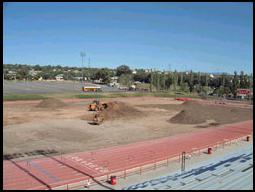 Before Rudy
Davalos was hired, the amount brought in was less than one-third of
that total. This, along with the generous aid of the State Legislature,
various govenors, local businesses and private donations, allowed Rudy
Davalos to begin turning those dreams of the past into the reality we
see today. Virtually every UNM athletics facility has received a facelift
since he arrived, and the process is ongoing. Already, he has added
two tennis bubbles for indoor play, along with new infield grass and
lights for the men's and women's soccer and track and field teams. Before Rudy
Davalos was hired, the amount brought in was less than one-third of
that total. This, along with the generous aid of the State Legislature,
various govenors, local businesses and private donations, allowed Rudy
Davalos to begin turning those dreams of the past into the reality we
see today. Virtually every UNM athletics facility has received a facelift
since he arrived, and the process is ongoing. Already, he has added
two tennis bubbles for indoor play, along with new infield grass and
lights for the men's and women's soccer and track and field teams.
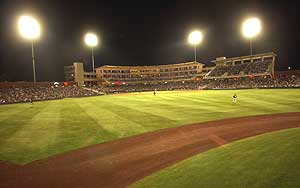 And
then there is Isotopes Park - home of Lobo baseball. One of the finest
baseball facilities in the nation and voted the top collegiate baseball
field in 2004 by the SportsTurf Managers Association. Seating 11,124
fans, the new stadium has approximately 66,500 square feet of exterior
seating plus 3,440 square feet of exterior suite seating. It has 54,300
square feet of open concourse and walkway plus 4,540 square feet of
outdoor deck, 66,400 square feet enclosed space, 7,000 square feet of
open outdoor picnic area and a 120,000 square foot playing field. And
then there is Isotopes Park - home of Lobo baseball. One of the finest
baseball facilities in the nation and voted the top collegiate baseball
field in 2004 by the SportsTurf Managers Association. Seating 11,124
fans, the new stadium has approximately 66,500 square feet of exterior
seating plus 3,440 square feet of exterior suite seating. It has 54,300
square feet of open concourse and walkway plus 4,540 square feet of
outdoor deck, 66,400 square feet enclosed space, 7,000 square feet of
open outdoor picnic area and a 120,000 square foot playing field.
Simply
beautiful.
And he
hasn't forgotten about that old "cash cow" of ours, either.
Sometime
in November of 2005, a state-of-the-art practice facility will be completed
for the men's and women's basketball teams. The $4.2 million project
features a practice facility and new offices for both the Lobo men's
and women's basketball coaches and staff.
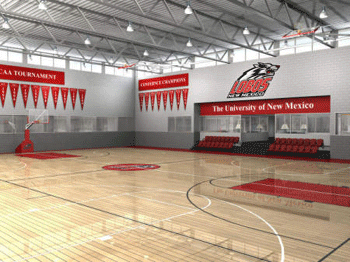 In
addition to the practice court and offices, the 26,000 sq-ft complex
will have coaches' locker rooms, a video room, computer lab, hospitality
area with a caterer's kitchen, media workroom and a stylish lobby entrance
that will showcase the history and tradition of the men's and women's
basketball teams. In
addition to the practice court and offices, the 26,000 sq-ft complex
will have coaches' locker rooms, a video room, computer lab, hospitality
area with a caterer's kitchen, media workroom and a stylish lobby entrance
that will showcase the history and tradition of the men's and women's
basketball teams.
Certainly
nice,
but Rudy Davalos has been taking care of the venerable old Pit for quite
some time now. Renovations and much-needed exterior landscaping were
provided by the late nineties and just a few years later, Davalos was
already thinking about an even greater transformation. Currently, studies
are underway on plans to include a new or reinforced roof to hold a
state-of-the-art scoreboard, additional seating, restrooms and concessions.
A
big project and a costly one, that Davalos intends to see become a reality
before his time here at New Mexico comes to an end. For those doubting
that the project will ever see the light of day, the people who know
the man behind New Mexico athletics will be quick to give a serious
warning: Don't bet against Rudy Davalos.
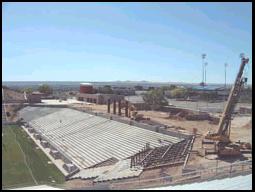 Nowhere is
there more proof of this, than in the amazing improvements he has brought
about to University Stadium. Beginning back in 1992, Rudy was able to
get approved a plan through sheer will it seemed, that would renovate
and modernize the football program in five phases. Much grander than
Bridger's vision, Davalos nonetheless succeeded where Bridger had earlier
failed. Nowhere is
there more proof of this, than in the amazing improvements he has brought
about to University Stadium. Beginning back in 1992, Rudy was able to
get approved a plan through sheer will it seemed, that would renovate
and modernize the football program in five phases. Much grander than
Bridger's vision, Davalos nonetheless succeeded where Bridger had earlier
failed.
This
Master Plan for expansion of University Stadium proposed increased seating
for 43,000 spectators, enlarged and improved restrooms and concessions,
and the creation of a continuous concourse around the facility by enclosing
the endzones.
Phase
I of the project was to construct a new training facility. The former
building was such an eyesore and so antiquated that it was a common
practice for coaches to steer any potential recruits away from it.
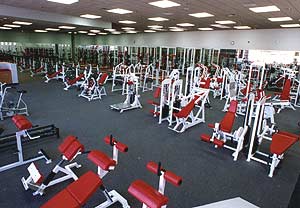 That
all changed in 1995 with the unveiling of the $8.5 millionTow Diehm
Athletics Facility, one of the premier training facilities to be found
anywhere in intercollegiate athletics. That
all changed in 1995 with the unveiling of the $8.5 millionTow Diehm
Athletics Facility, one of the premier training facilities to be found
anywhere in intercollegiate athletics.
Ex-Lobo
and former Green Bay Packer defensive back Scott McGarrahan called it
"probably the best weight room I've ever been in. Without it, I wouldn't
be where I am today."
UNM
would not be where it is today either, according to Davalos.
"If
the Tow Diehm building had not been built and the facilities had stayed
the way they were," Davalos said, "we'd be playing in the Western Athletic
Conference."
The
next phase completed was a $1.5 million renovation of the concession
area and restrooms in the northwest corner of the stadium in October
of 2000. The best was yet to come though, with the unveiling of a $3.6
million expansion of University Stadium in August of 2001. This included
adding 5,946 seats that enclosed the north endzone and "LoboVision,"
a huge, state-of-the-art video scoreboard.
The
final phases are lagging a little behind right now, due to that age-old
problem here in New Mexico - lack of funding. The State Legislature
bailed out on an earlier commitment to finance the construction, and
a major donor has been impossible to find thus far. Nevertheless, this
project will one day be completed, and it will mostly be due to one
man: Rudy Davalos.
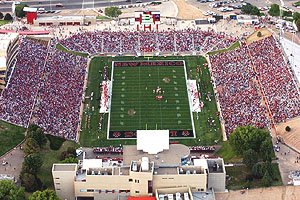 Already,
an indoor practice facility has been added to the wish list, but the
feisty athletic director has been in the "wish business" ever
since he first set foot in New Mexico. Already,
an indoor practice facility has been added to the wish list, but the
feisty athletic director has been in the "wish business" ever
since he first set foot in New Mexico.
To
understand the magnitude of the deal-making and financial "wrangling"
Rudy has been able to pull off in New Mexico so far, all one has to
do is to look for parallels inside our own conference. Well - actually,
there are none since the only members to undergo major renovations since
1997 (Utah and UNLV) got far more money through more conventional means
to complete their work.
Utah
received $50 million to rebuild Rice stadium and UNLV received $19 million
for Sam Boyd Stadium renovations. Both projects were done in one phase
- not by the piecemeal system that UNM is forced to use.
In
addition, each project was funded by sources completely unavailable
to us. Utah got both public and private funding because the stadium
was to be used in the 2002 Winter Olympics, while UNLV was able to get
a large chunk of money from the city's convention bureau since the stadium
is the yearly site for a bowl game.
It
is the perhaps the truest measure of the man himself, that Rudy Davalos
has never let underdog status or long odds keep him down. Such a man
makes his share of enemies, however. Not everyone appreciates athletics
and those who do, are often never satisfied because they fail to understand
the dynamics (or lack thereof) driving this state. By the year 2003,
athletic budgets of $40 million were no longer rare in this country,
and in fact, there are a few out there exceeding $100 million dollars.
It makes you kind of wonder how New Mexico is still able to compete
on a level playing surface, eh?
For
many at the university, just as in years past, they couldn't care less.
UNM
professor Peter Dorato has been a long-time critic of Lobo football,
and has seldom failed to speak out against the appropriation of funds
for the program.
"To
have winning teams in football," said Dorato, you need people who are
good football players, who spend a lot of time at it and who spent a
lot of time at it in high school, and hence less on their academic preparation"
(Obviously, this professor is some sort of freakish genius).
"I
can't get journals I need because they say we don't have enough money
and yet, they can expand the stadium. How's that possible?"
Perhaps
Professor Dorato (fine engineering professor that he is) would prefer
teaching at the schoolhouse from "Little House On the Prairie" fame.
That is not too far removed from what UNM would be without the allure
and entertainment value of athletics. Right or wrong, it is the most
recognized face behind the educational robes. It is a well-known fact
that the registration of new students (the vast majority of whom are
not athletes) often rises and falls with the fortunes of a particular
team, and the subsequent press that it generates.
Professor
Dorato was far from alone in his criticism. Cisco McSorley, a member
of the state legislature for 20 years, says no matter how much money
goes into improving the football program, it never seems to be enough.
"We
were told a huge top (the press box built in 1976) would change the
program,"
he says speaking as a former graduate. "We were told a weight room would
change the program. But I don't see the stadium busting out at the seams
on a regular basis for home games."
Oh,
but that isn't quite true, Mr. McSorely.
On
September 17th of 2005, a record crowd of 44,760 people watched the
Lobos defeat cross-state rivals, New Mexico State. Every year for the
past four seasons, Lobo football has eclipsed the previous record for
total attendance. This season - as in the previous three, a new record
for season ticket purchases was set, which is the truest barometer of
success for a program that I know of.
Three
straight Bowl Game appearances for the first time in school history,
doesn't hurt either.
Lobo
football has indeed turned the corner under Rudy Davalos, and
you don't need to be an engineering professor or a state legislator
to see that.
Needless
to say, those
and countless other skeptics and non-believers have not deterred Rudy
Davalos from doing what he saw was in the best interests of the University
of New Mexico. In fact, the only thing that seems to matter more to
him than recruiting quality athletes to New Mexico, is the recruiting
of quality student - athletes to the university.
In
the year 2000-01, the athletes representing UNM's 21 intercollegiate
sports combined for the two highest semester grade point averages since
the school began keeping track of them in 1988. Those Lobos recorded
a 2.91 GPA during the fall and spring semesters. This would make nine
straight semesters (under Davalos) the Lobos had attained a 2.80 GPA
or higher. Eleven UNM student-athletes were named to academic All-America
teams while an amazing 109 earned all-conference honors.
Before
Davalos' tenure, the GPA was a mere 2.73. By the spring of 2005, the
standard had been pushed to 3.02, marking the sixth straight semester
the Lobos had surpassed a 3.0 average.
War
is not always pretty though, and there were casualties along the way.
Men's swimming, gymnastics, and wrestling were all given the hatchet,
mostly to meet Title IX compliance. It was also in keeping with the
general configuration of other schools in the Mountain West Conference.
This may or may not have been the wisest decision of the Davalos administration,
and critics are still extremely vocal in protesting it today. At any
rate, Title IX compliance is not a voluntary decision in modern
athletics - it is a legal one. UNM could not afford to have federal
dollars withheld by overzealous lawyers intent on upholding the letter
of the law, so the point is moot.
Clearly,
Rudy Davalos has proven himself to be an extremely capable administrator
and fundraiser, but how did this eventually translate out onto the field
where the fans chose to pass judgement? Did he ever find his own Joe
Morrison to fill those extra seats, and would he retain him after football
glory was acheived?
The
answer to that question is, "Yes, he got what he wanted, but he lost
what he had. In doing so, he found what he was looking for the whole
time."
Sound
confusing? Well, hopefully the other chapters in this series will explain
that story in greater detail. Of course with Rudy Davalos, anything
is possible.

| 


